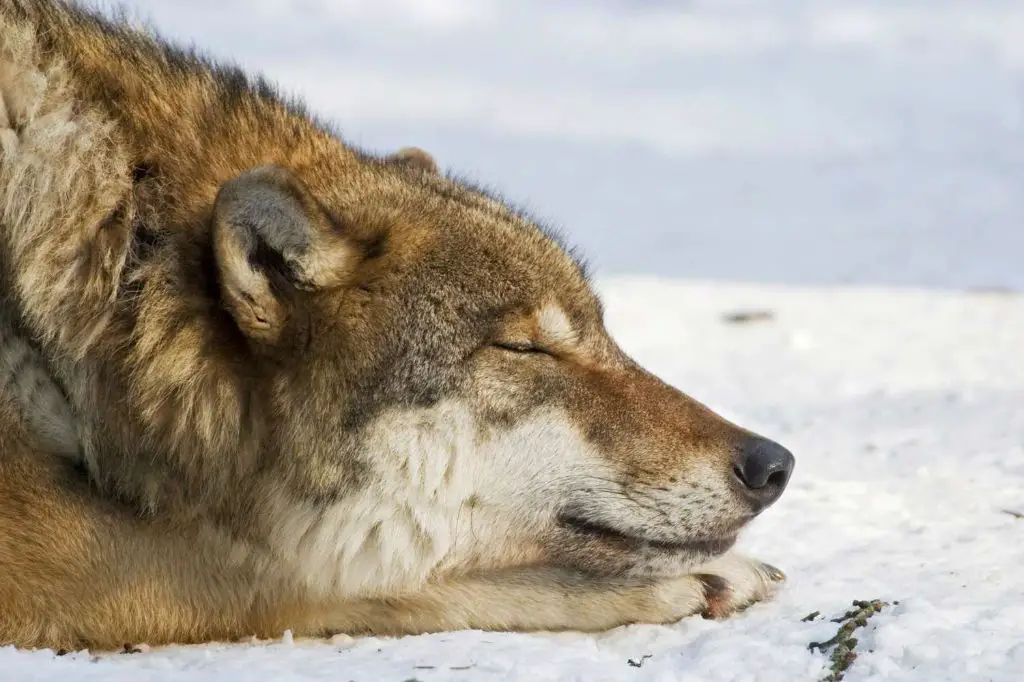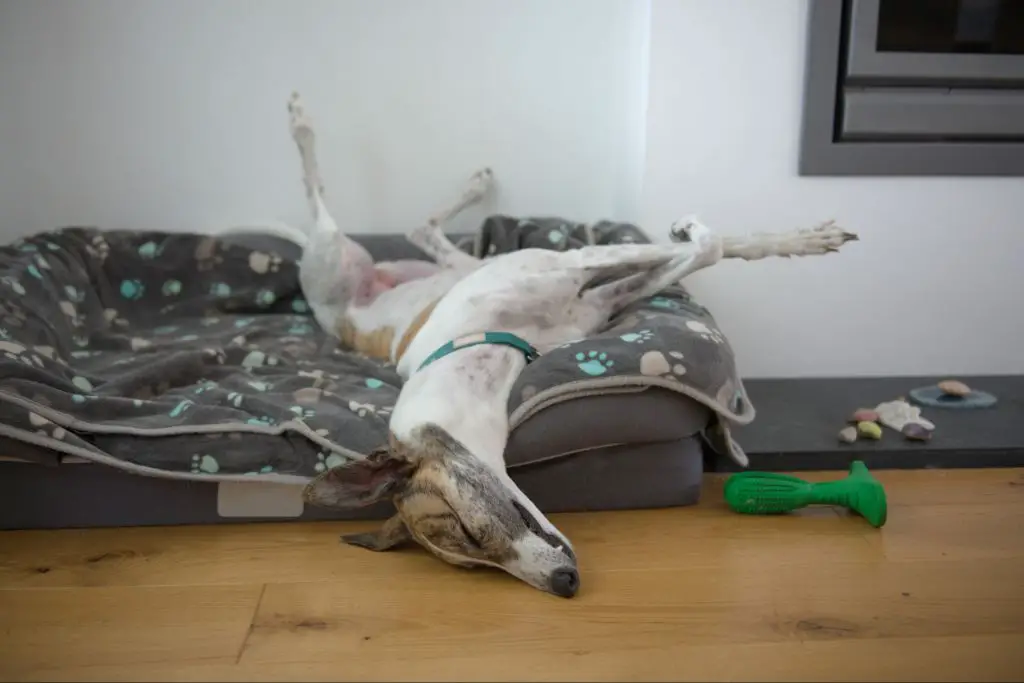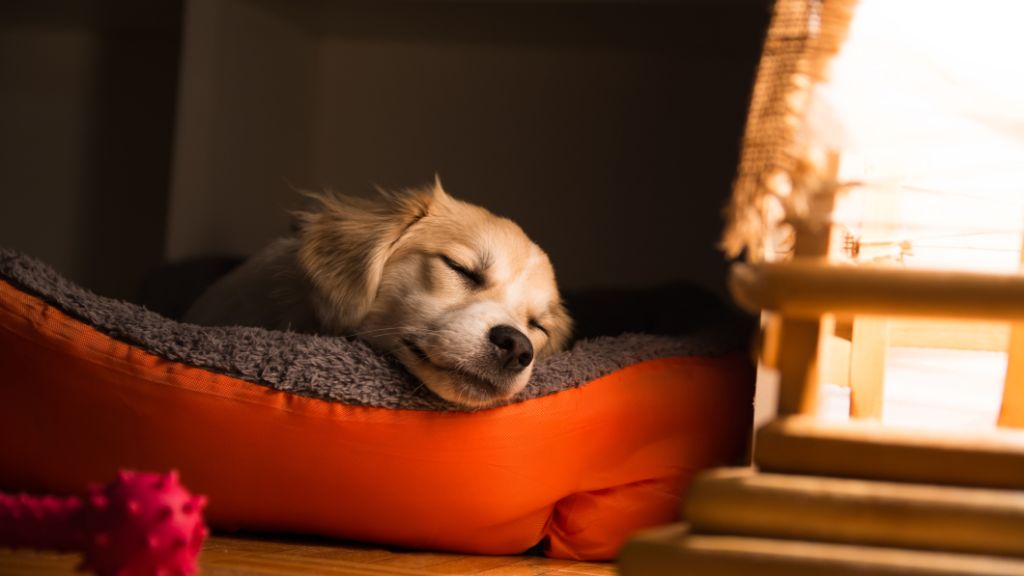Introduction
Dogs display a range of sleep patterns that can be influenced by various factors like ancestry, breed, age, and their owners’ habits. This article will provide an overview of dog sleeping habits, explaining the differences between diurnal, crepuscular, and nocturnal activity cycles. We’ll take a look at how evolution has shaped canine sleep patterns as well as how variables like breed, age, and owner schedules impact their sleep-wake rhythms. Tips will be provided for owners to help promote healthy, high-quality sleep for their dogs.
Definitions of Diurnal, Crepuscular and Nocturnal
The sleep-wake cycles of animals are often categorized into three types:
Diurnal animals are awake during the daytime and sleep at night. Birds and lizards are common examples of diurnal species.
Nocturnal animals are awake during the nighttime and sleep during the day. Examples include bats, raccoons, and opossums.
Crepuscular animals are most active during twilight hours at dawn and dusk. Many mammals like deer, rabbits, and house cats tend to be crepuscular.
These behavioral patterns evolved as adaptations to avoid predators, maximize food resources, and take advantage of ambient temperatures during certain times of day. By understanding a pet’s natural sleep-wake rhythms, owners can better meet its needs.
Dog Ancestry
The domestic dog originated from the gray wolf tens of thousands of years ago. Through domestication by early humans, dogs became distinct from wolves in both physical characteristics and behavior. However, dogs still share many traits with their wolf ancestors when it comes to sleep patterns and preferences.
Wolves are crepuscular animals, meaning they are most active during twilight hours at dawn and dusk. This crepuscular behavior is likely an evolutionary adaptation to avoid daytime predators and nighttime prey that may better detect wolves under the full moon.

Wolves typically sleep during the day when they are inactive, and at night for a few hours between periods of activity. They generally sleep near other members of the pack for warmth and protection.
Since dogs evolved from wolves, they inherited some of the same sleep habits and instincts. Feral and free-roaming dogs tend to be crepuscular like wolves, with high activity levels at dawn and dusk for hunting and scavenging.
Dog Sleep Patterns
Dogs have sleep patterns that are mostly polyphasic, meaning they tend to have multiple periods of sleep and wakefulness throughout the 24-hour day. Most dogs will be awake and active for a portion of the day, then have several short naps rather than one long, consolidated sleep period at night. The amount of sleep a dog gets during a 24-hour cycle varies by breed and age, but adult dogs on average sleep over 12 hours a day.
A dog’s main sleep period tends to be at night when the owners are also sleeping. However, their sleep is usually divided into multiple shorter cycles, rather than one continuous sleep. Dogs may spend only a portion of the night in deep, REM sleep. The amount of nighttime sleep may range from 6-10 hours for an adult dog. Puppies will need closer to 18-20 hours of sleep in a 24-hour period.
In addition to nighttime sleep, dogs also typically have short naps during the daytime. Adult dogs may nap for a total of a couple hours during the daytime. These naps are important for dogs to recharge their energy and stay alert when awake. Daytime napping often occurs after meals, playtime or walks. Dogs like having dedicated sleeping areas during the day, just as they do at night.
Overall, dogs tend to be polyphasic sleepers with divided sleep periods alternating with wakefulness both at night and during the day. However, there is variation between breeds and individuals. Some dogs may sleep more at night, while others nap more frequently in the day. Owners can observe their individual dog’s preferences and set up an appropriate daily schedule and sleeping areas to accommodate their needs.
Influence of Owners
A dog’s sleep schedule is often heavily influenced by their owner’s schedule and lifestyle. Dogs are pack animals that have evolved to synchronize their behavior with the rest of their pack. Since most dogs see their human family as their pack, they will naturally try to follow the routines and rhythms of their owners.
For example, if an owner works during the day and is gone for 8-10 hours, the dog may learn to sleep more during the day while the owner is away. The dog may then be more active and awake in the evenings and at night when the owner is home. On the other hand, a dog that lives with an owner who works nights and sleeps during the day may adjust and become more nocturnal themselves, sleeping when the owner sleeps.
Things like feeding schedules, walk times, play time and training sessions will also influence a dog’s sleep-wake cycles. A dog fed first thing in the morning or last thing at night will likely synchronize around those feedings. Dogs walked or played with in the evenings may have more energy and alertness at night. Owners can shape a dog’s schedule through the daily routines they establish.
Overall, most companion dogs will align their sleep patterns to their owners’ schedules and activity levels to some degree. Their natural instincts drive them to be awake and alert when their human “pack” is active and asleep when their pack rests. With consistent routines guided by the owner, dogs can adapt to being awake during the day, night, or brief periods at dawn/dusk.
Breed Differences
Dogs come in a variety of shapes and sizes, so it’s no surprise that different breeds exhibit some differences when it comes to their sleep cycles and patterns. Some of the key differences include:
Working/high energy breeds like Border Collies, Australian Shepherds, and Siberian Huskies tend to have more nocturnal tendencies and be more active at night. As herding and sled dog breeds, they were bred to work and be alert at all hours.
Sighthounds like Greyhounds and Whippets are prone to short bursts of high energy and then long naps during the day. Their sleep patterns follow their hunting ancestry, with quick intense movement and then rest.

Guard/watchdog breeds like Rottweilers, Dobermans, and Great Danes tend to be more alert and active at night as that is when they would traditionally stand guard and protect homes or property.
Ancient/primitive breeds like Shiba Inus, Akitas, and Chow Chows are more nocturnal as they are closer genetically to wild wolves who are active at night. These breeds like to sleep during the day.
While general breed tendencies exist, at the end of the day each dog is an individual. Factors like age, health, environment, and training play a big role as well. But being aware of a breed’s ancestry and typical sleep patterns can help owners better understand their dog’s rhythms.
Age Differences
Sleep patterns in dogs can vary significantly depending on the dog’s age and stage of life. Puppies, adult dogs, and senior dogs all have different sleep needs and habits.
Puppies tend to sleep a lot more than adult dogs, needing about 18-20 hours of sleep per day. This is because puppies are growing rapidly and sleep is essential for their development. Puppies have short attention spans when awake and will readily fall asleep throughout the day for naps. They are often very playful and energetic when awake, then crash for a nap shortly after. Puppies also tend to wake more frequently overnight compared to adult dogs.

Adult dogs settle into a more routine sleep pattern, typically sleeping around 12-14 hours per day. They have longer awake periods during the day and sleep more solidly overnight. Their sleep needs stay consistent in adulthood until they reach senior age.
As dogs reach their senior years, around age 7+, their sleep patterns change again. Senior dogs tend to sleep more during the day, take more frequent naps, sleep more lightly and for shorter time periods. They also tend to wake more often overnight and have difficulty settling back to sleep. Restlessness and pacing at night can be common in senior dogs.
Understanding these age differences can help owners better meet their dog’s needs. Puppies may need more daytime naps and overnight potty breaks, while senior dogs benefit from a comfortable bed in a quiet space for undisturbed daytime rest.
Health Impacts
A dog’s natural sleeping patterns can have significant impacts on their overall health and wellbeing. Dogs that do not get adequate sleep or have disrupted sleep cycles may experience both physical and mental health problems. Some of the key health connections include:
- Inadequate Sleep: Dogs that are frequently woken during their natural sleep times or are unable to get enough total sleep each day may suffer impaired cognitive function, reduced immunity, weight gain, irritability, and behavior issues.
- Disrupted Circadian Rhythms: Dogs, like humans, have internal circadian rhythms that regulate hormone production, digestion, and other bodily functions according to the sleep-wake cycle. Disrupting these rhythms through irregular sleep schedules or light exposure at night can lead to disrupted metabolisms and impaired health over time.
- Stress and Anxiety: Dogs with insufficient or low quality sleep often exhibit higher stress and anxiety levels. Their sleep disturbances may also be symptomatic of underlying anxiety issues.
- Obesity: Studies show links between inadequate sleep and weight gain in dogs, likely due to impacts on metabolism and appetite-regulating hormones.
- Joint Pain: Older dogs especially rely on sleep to give their joints relief from the stresses of activity during the day. Insufficient rest at night can exacerbate joint pain and arthritis.
Making sure your dog gets ample sleep opportunity during their natural active and rest periods can go a long way in supporting their physical and mental health.
Tips for Owners
There are several things owners can do to allow their dogs to follow their natural sleep patterns and cycles:
- Don’t disrupt your dog’s schedule by waking them during their natural sleep times. Allow them to wake up naturally.
- Make sure your dog gets sufficient exercise and activity during their awake periods so they are tired when it’s time to sleep.
- Provide a comfortable, quiet area for your dog to sleep undisturbed.
- Follow a consistent daily routine so your dog’s body can align to their natural rhythms.
- Pay attention to your breed’s typical sleep patterns – some do better with daytime naps while others sleep more at night.
- Avoid bright lights or loud noises during your dog’s sleep times.
- Consider using blackout curtains or a covered crate if necessary.
- Talk to your vet if you have concerns about abnormal sleep patterns or health issues disrupting sleep.

By making small adjustments, owners can help create an environment where their dog’s natural bio-rhythms and sleep cycles can flourish.
Conclusion
In summary, the sleeping habits of dogs are influenced by a variety of factors such as ancestry, breed, age, and their owners’ schedules. While some general trends exist, each dog is unique in terms of whether they tend to be more active during the day, twilight, or night.
Key takeaways for owners include:
- Pay attention to your individual dog’s sleep patterns and accommodate their needs as much as possible.
- Create a calm sleeping area away from noise and activity.
- Stick to a routine with regular feeding times, exercise, playtime, and walks.
- If your schedule requires your dog to be awake when they want to sleep, allow for naps during their natural active periods.
- Consult your veterinarian if you have concerns about abnormal sleep patterns or sleeping difficulties.
While dogs may not strictly adhere to the classifications of diurnal, crepuscular, or nocturnal, understanding their natural tendencies can help owners better care for their health and happiness.